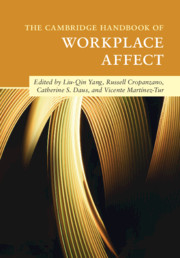Book contents
- The Cambridge Handbook of Workplace Affect
- The Cambridge Handbook of Workplace Affect
- Copyright page
- Contents
- Figures
- Tables
- Contributors
- Foreword
- Part I Theoretical and Methodological Foundations
- 1 Emotion at Work
- 2 The Organizational Neuroscience of Emotions
- 3 Personality Affect Construal Theory
- 4 Workplace Emotions and Motivation
- 5 Behavioral Genetics and Affect at Work
- 6 A Review of Quantitative Methods to Measure Workplace Affect
- 7 Qualitative Methods to Study Workplace Affect
- Part II Workplace Affect and Individual Worker Outcomes
- Part III Workplace Affect and Interpersonal and Team-Level Processes
- Part IV Workplace Affect and Organizational, Social, and Cultural Processes
- Part V Discrete Emotions at Work
- Part VI New Perspectives on Workplace Affect
- Index
- References
3 - Personality Affect Construal Theory
A Model of Personality and Affect in the Workplace
from Part I - Theoretical and Methodological Foundations
Published online by Cambridge University Press: 25 June 2020
- The Cambridge Handbook of Workplace Affect
- The Cambridge Handbook of Workplace Affect
- Copyright page
- Contents
- Figures
- Tables
- Contributors
- Foreword
- Part I Theoretical and Methodological Foundations
- 1 Emotion at Work
- 2 The Organizational Neuroscience of Emotions
- 3 Personality Affect Construal Theory
- 4 Workplace Emotions and Motivation
- 5 Behavioral Genetics and Affect at Work
- 6 A Review of Quantitative Methods to Measure Workplace Affect
- 7 Qualitative Methods to Study Workplace Affect
- Part II Workplace Affect and Individual Worker Outcomes
- Part III Workplace Affect and Interpersonal and Team-Level Processes
- Part IV Workplace Affect and Organizational, Social, and Cultural Processes
- Part V Discrete Emotions at Work
- Part VI New Perspectives on Workplace Affect
- Index
- References
Summary
Even decades after the affective revolution (Ashkanasy & Dorris, 2017), affect remains an integral part of organizational psychology. The two primary perspectives in affective research center on affect as a dispositional construct (i.e. a trait) or a momentary construct (i.e. a state) (Brief & Weiss, 2002). Dispositional perspectives of affect refer to a general tendency to experience certain types and levels of affective state. This can reflect personality traits and affective dispositions (Watson & Clark, 1984; Watson & Tellegen, 2002). Momentary affect refers to emotions experienced in the moment, including both the valence of feelings (i.e. positive, negative) and discrete emotions (e.g. guilt, awe). Integrating person, situation, and emotional construal perspectives, this chapter seeks to incorporate decades of work on affective dispositions, momentary affect, and personality to present a conceptual model that specifies how these come together to produce in-the-moment emotions embedded in specific situations. In doing so, we provide theoretical specificity connecting these dispositional and momentary perspectives, answering the call for more multi-level and systems-based theories: for example, how does personality unfold to impact state-level emotions (Ilies, Schwind, & Heller, 2007)?
- Type
- Chapter
- Information
- The Cambridge Handbook of Workplace Affect , pp. 37 - 51Publisher: Cambridge University PressPrint publication year: 2020
References
- 1
- Cited by



